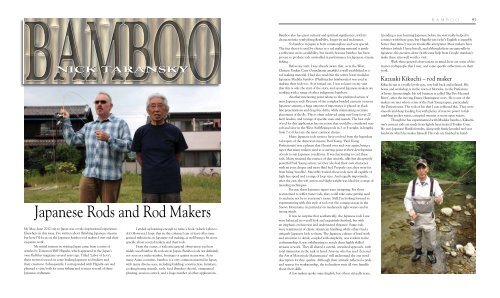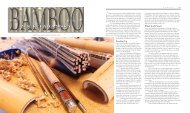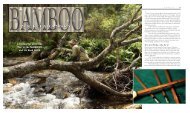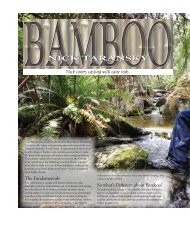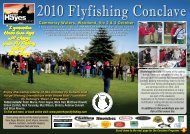Japanese Rods and Rodmakers - NA Taransky Bamboo Rods
Japanese Rods and Rodmakers - NA Taransky Bamboo Rods
Japanese Rods and Rodmakers - NA Taransky Bamboo Rods
Create successful ePaper yourself
Turn your PDF publications into a flip-book with our unique Google optimized e-Paper software.
92 FLYFISHER BAMBOO 93Nick <strong>Taransky</strong><strong>Japanese</strong> <strong>Rods</strong> <strong>and</strong> Rod MakersMy May–June 2012 trip to Japan was a truly inspirational experience.Elsewhere in this issue, I’ve written about flyfishing <strong>Japanese</strong> streamsbut here I’ll focus on the <strong>Japanese</strong> bamboo rod makers I met <strong>and</strong> theirexquisite work.My initial interest in visiting Japan came from a series ofarticles by Tomonori ‘Bill’ Higashi, which appeared in the Japan’sown FlyFisher magazine several years ago. Titled ‘Labor of Love’,these stories focused on some leading <strong>Japanese</strong> rod makers <strong>and</strong>their creations. Subsequently, I corresponded with Higashi-san <strong>and</strong>planned a visit; both for some fishing <strong>and</strong> to meet several of these<strong>Japanese</strong> craftsmen.I ended up learning enough to write a book (which I plan todo!) However, I hope that in this column I can at least offer somegeneral reflections on <strong>Japanese</strong> rod making, as well being a bit morespecific about several makers <strong>and</strong> their rods.From the outset, a welcome general observation was howwidely used bamboo fly rods are in Japan. <strong>Bamboo</strong> rods are definitelynot seen as a niche market, boutique or quaint in any way. As inmany Asian countries, bamboo is a very common material in Japan,with many diverse uses, including building/ construction, furniture,cooking/eating utensils, tools, food (bamboo shoots), ornamentalplanting, erosion control, <strong>and</strong> a huge number of other applications.<strong>Bamboo</strong> also has great cultural <strong>and</strong> spiritual significance, with itscharacteristics symbolising flexibility, longevity <strong>and</strong> endurance.So bamboo in Japan is both commonplace <strong>and</strong> very special.The fact that it is used by choice as a rod making material is partlya reflection on its availability, but mostly because bamboo has beenproven to produce rods unrivalled in performance for <strong>Japanese</strong> streamfishing.Before my visit, I was already aware that, as in the West,Chinese Tonkin Cane (Arundinaria amabilis) is well established as arod making material. I had also read that the softer, lower modulus<strong>Japanese</strong> Madake bamboo (Phyllostachys bambusoides) was used inmaking their rods too. As it turned out, I was to learn on my visitthat this is only the start of the story, <strong>and</strong> several <strong>Japanese</strong> makers areworking with a range of other indigenous bamboos.Another interesting point relates to the preferred action ofmost <strong>Japanese</strong> rods. Because of the complex braided currents on most<strong>Japanese</strong> streams, a huge amount of importance is placed on slackline presentations <strong>and</strong> drag-free drifts, while maintaining accurateplacement of the fly. This is often achieved using very long (over 20feet) leaders, <strong>and</strong> a range of specific casts <strong>and</strong> mends. The best styleof rod for this application has an action that would be considered verysoft <strong>and</strong> slow in the West. Full flexing rods in 3 or 4 weight, in lengthsfrom 7 to 8 feet are the most common choice.Many <strong>Japanese</strong> rods seem to have evolved from the legendaryrod tapers of the American master, Paul Young. ‘Paul YoungPerfectionist’ was a phrase that I heard over <strong>and</strong> over again, being ataper that many makers used as a starting point in their developmentof rods to suit <strong>Japanese</strong> conditions. It was fascinating to cast theserods. Many retained the essence of that smooth, silky but deceptivelypowerful Paul Young action, yet they also had their own character,with an even deeper <strong>and</strong> more fluid feel. Properly cast, they were farfrom being ‘noodles’. Smoothly loaded, these rods were all capable ofhigh line speed <strong>and</strong> a range of loop sizes. And equally importantly,after the cast, the soft action <strong>and</strong> slight weight was ideal for a range ofmending techniques.For me, these <strong>Japanese</strong> tapers were intriguing. For thoseaccustomed to stiffer, faster rods, they could take some getting usedto <strong>and</strong> may not be to everyone’s tastes. Still, I’m looking forward toexperimenting with this style of rod over the coming season in theSnowy Mountains, in particular on moderately tight waters <strong>and</strong> instrong winds.It was no surprise that aesthetically, the <strong>Japanese</strong> rods I sawwere balanced in overall look <strong>and</strong> exquisitely finished, but withan emphasis on function <strong>and</strong> understated elegance. Some rodswere reminiscent of classic American finishing, while others had auniquely <strong>Japanese</strong> look to them. The <strong>Japanese</strong> culture of hard work<strong>and</strong> attention to detail, coupled with simplicity, was evident in thecraftsmanship. It was exhilarating to watch these highly skilledartisans at work. They all shared a careful, unrushed approach, withtotal immersion in the task at h<strong>and</strong>. Anyone who has read ‘Zen <strong>and</strong>the Art of Motorcycle Maintenance’ will underst<strong>and</strong> the one worddescription for this: quality. Although their attitude reflected a pride<strong>and</strong> respect for workmanship, the rod makers were all very humbleabout their skills.A few makers spoke some English, but others virtually none.Spending a year learning <strong>Japanese</strong> before my visit really helped toconnect with these guys, but Higashi-san (who’s English is arguablybetter than mine!) was an invaluable interpreter. Most makers havewebsites (which I have listed), <strong>and</strong> although these are generally in<strong>Japanese</strong>, the pictures alone (with some help from Google translate)make these sites well worth a visit.With these general observations in mind, here are some of themaster craftspeople that I met, <strong>and</strong> some specific reflections on theirwork.Kazuaki Kikuchi – rod makerKikuchi-san is a really lovely guy, very laid back <strong>and</strong> relaxed. Hishome <strong>and</strong> workshop is in the town of Morioka, in the Prefectureof Iwate. Interestingly, his rod business is called ‘Big Two HeartedRiver’, after the moving Ernest Hemingway story. He is one of themakers we met who is a fan of the Paul Young tapers, particularlythe Perfectionist. The rods of his that I cast reflected this. They weresmooth <strong>and</strong> deep loading, but with plenty of reserve power to fishtumbling pocket water, canopied streams or more open waters.Though he has experimented with Madake bamboo, Kikuchisan’scurrent rods are made from lightly heat-treated Tonkin Cane.He uses <strong>Japanese</strong> Hariki ferrules, along with finely knurled reel seathardware which he makes himself. His rods are finished in h<strong>and</strong>-
94 FLYFISHER BAMBOO 95rubbed Tung Oil, revealing a subdued, natural look, <strong>and</strong> on theones I saw, accented with golden guide <strong>and</strong> ferrule wraps <strong>and</strong> fineblack tipping. Reel seat timbers are brown burl, which looks a littlelike some of the brown mallee I use. His grips are either a cigar orfull wells, depending on the model of the rod. The ferrules featurea hexagonal rod section <strong>and</strong> cork ferrule plug, with a lanyard whichmatches a hanging loop on the rod bag. His wife makes his rod bags,which also feature a fish motif button.Kikuchi-san learnt rod making by translating the Garrisonbook with an English-<strong>Japanese</strong> dictionary. This is no mean feat– if you’ve seen the Garrison book, you’ll know it can be prettyoverwhelming, even in your native language!Kikuchi-san’s website is www.bthr.netNaoto Shibuya – rod makerShibuya-san is a full-on character. Based in the town of Kawatsurain the Akita Prefecture, his family business is in the beautiful (buthighly toxic to most) Urushii lacquer. Many people have seen Urushiivarnish on black, red, <strong>and</strong> clear <strong>Japanese</strong> bowls, cups <strong>and</strong> chopsticks(don’t worry – it’s only toxic before it hardens!) In addition to his rodmaking <strong>and</strong> Urushii lacquer work, Shibuya-san is a noted flyfishingauthor, guide, instructor <strong>and</strong> tackle designer – he designs hooks <strong>and</strong>LDL fly lines <strong>and</strong> leaders. He has also produced three instructionalflyfishing DVDs. His rod making <strong>and</strong> fishing are based on usingloooong leaders (20 foot plus) <strong>and</strong> long drag free drifts. Watching himfish is like nothing I’ve ever seen.Like Kikuchi-san, he makes rods from powerful Tonkin Cane.He also mentions the Paul Young Perfectionist as a starting point,but as he says, his rods have now evolved a long way from that point.They are 3 <strong>and</strong> 4 weights, from 7’2” to 7’9”. To me they feel likethey have the essence of the Perfectionist to them, but are maybelighter through the tip <strong>and</strong> with more taper <strong>and</strong> power into the butt.However, they still have a more continuous feel <strong>and</strong> action than say,Payne style, ‘fast’ dry fly rods.Shibuya-san’s rods use custom <strong>Japanese</strong> Hariki ferrules <strong>and</strong>reel seat hardware, which he oxidises to a dark finish. The rods arevarnished in a warm reddish gold gloss, over mottled flamed cane.The reel seat <strong>and</strong> bullet-shaped ferrule plug are finished in exquisiteUrushii lacquer. The wraps are unique. He uses a gold tinsel thread,but varnishes over them in dark brown/plum Urushii. This resultsin a colour that blends in with the bamboo, but with faint goldenhighlights. The grips are a shallow taper <strong>and</strong> very comfortable fullwells.Shibuya-san’s website is www.kawatsura.comSao-Naka – rod makerSao-Naka-san is a Tokyo based rod maker. He does make split canerods, but his core profession is making whole culm rods. These are,as the name suggests, whole, fine, culms of bamboo (from speciessuch as Yadake or Arrow <strong>Bamboo</strong> – Pseudosasa japonica), made intomulti-section rods. I had envisaged something basic like our old styleRangoon Cane surf rods. Although the principle at the fundamentallevel is the same, these rods are maybe the most refined <strong>and</strong> delicateI have ever seen. This old craft is highly respected in Japan, <strong>and</strong> theapprenticeship for becoming an established maker is an astonishing 25years! Sao-Naka-san has been working on his own for 5 years after 25years under his master, so he has 30 years’ experience in his field. Thename ‘Sao-Naka’ itself is recognition of his profession. ‘Sao’ (or ‘Zao’),means ‘Fishing Rod’, <strong>and</strong> ‘Naka’ comes from his original family name.These whole culm rods are exquisite, <strong>and</strong> difficult to do justiceto in a few paragraphs. From the very start, culm selection is critical,as there is no opportunity to change the taper of a culm throughplanning or shaping. Additionally many of these rods are formed frommany culms, with part of each culm being chosen for one of manysections in the rod – rods may be 8 pieces or more, with sectionsfitting together like a modern sleeve-ferruled graphite rod.Some of these rods are made as fly rods, but many are destinedto be ultra-light float fishing rods without reels, for tiny carp species,using hooks the equivalent of size 50 or even smaller. The line onthese reel-less rods runs through the inside of the rod sections (likethe Daiwa ‘interline’ style rods). The rods can be made to be quiteresilient, but apparently the true connoisseur seeks out a rod that is sofine <strong>and</strong> delicate, it sits on a knife-edge between sublime performance<strong>and</strong> imminent breakage!They are finished with Urushii lacquer, applied meticulouslywith the fingers. Sao-Naka-san speaks no English, but throughHigashi-san’s translation, it is evident that he is critical of his ownwork. Lacquer that looks perfect <strong>and</strong> that his customers rejoice infrustrates him – he tried to show me elements of the finish he ismotivated to improve.Sao-Naka-san was very generous in showing me some of histechniques <strong>and</strong> tools, <strong>and</strong> also gave me a whole culm to make into a 7foot 4 weight on my return to Australia. I am in the process of finishingit now. It’s been intriguing to work on. I’ve had a preliminary cast, <strong>and</strong>it feels more like a medium-tip action graphite rod than split cane.It’s interesting to note that Sao-Naka-san’s rods are in suchdem<strong>and</strong> that the rods he showed me were borrowed back fromcustomers. He has nothing in stock. He doesn’t have a website oradvertise.<strong>and</strong> highly respected rod maker, which has been his career since hewas sixty.It was a true honour to meet him – an experience that onits own was worth the trip to Japan. Nakamura-san owns a smalltackle store <strong>and</strong> workshop in the town of Kiryu in Gunma Prefecture.Walking into his store feels in some ways like stepping back into the1950s, with wooden spools of line <strong>and</strong> other vintage <strong>and</strong> collectibletackle. And yet he is a very progressive, leading edge rod maker. Afterinitial greetings, still at the front door of his workshop, he was verykeen to show me a sheet with photos of microscopic cross-sections ofhalf a dozen or more species of bamboo he is using <strong>and</strong> experimentingwith in his rod making. These included Tonkin, Madake, Medake,Yadake <strong>and</strong> others. He makes mainly 6 sided split cane rods, but alsowhole culm rods <strong>and</strong> hybrids (half split cane, half whole culm.)Nakamura-san had many projects <strong>and</strong> prototypes underway.One factor in his innovation, I think, is the wonderful collaborationUshu Nakamura – rod makerNakamura-san is another amazing character. Well into his eighties,he is into his third career. In early life he was involved in Pachinko –<strong>Japanese</strong> pinball gambling. After that, he was a champion breeder ofAkita dogs. This current chapter of his life sees him as a renowned
96 FLYFISHER BAMBOO 97that he has with close neighbor Kenshiro Shimazaki. Shimazaki-sanis an icon in <strong>Japanese</strong> flyfishing. He is a leading fly tier, a hook <strong>and</strong>tackle designer for Tiemco, <strong>and</strong> keeps Nakamura-san very busy fromwhat I could see!I cast a large range of Nakamura-san’s rods over the courseof an afternoon. They were all amazing, <strong>and</strong> each unique in theirown way. Most were made from Madake <strong>and</strong> other very low modulusbamboos, so had an amazing fluid feel. He also had a spliced TonkinPaul Young Midge-based rod, with scarf ferrules, that was as fast <strong>and</strong>tight as any bamboo you would wish to cast.The aesthetics of his rods to me are definitively <strong>Japanese</strong>.<strong>Bamboo</strong> ferrules, bamboo reel seat, semi blonde lemon bamboo finish,Kanji signing <strong>and</strong> poetry inscribed on the butt, <strong>and</strong> golden brass reelseat hardware to blend in with the bamboo. There are clear wraps,guides <strong>and</strong> tip tops that he makes himself <strong>and</strong> every other detailcomes together into a simple but beautiful rod.Nakamura-san has no website or email, no advertising orsocial media presence. All his work is word of mouth, <strong>and</strong> he isin such dem<strong>and</strong> that he has the luxury of being able to select hiscustomers. I was lucky enough to get on his list, so now I get toexperience the other side of what it’s like to wait for a rod!Harada-san – rod makerHarada-san is an Osaka-based rod maker. I only had the chance tomeet him briefly, over dinner, but I had seen photos of his work inJapan FlyFisher, <strong>and</strong> was able to cast two of his recent rods duringmy visit. Harada-san makes rods for <strong>Japanese</strong> trout using Madakebamboo. He feels that the supple feel of this material suits the fish<strong>and</strong> the fishery. The rods I cast were finished beautifully <strong>and</strong> also castvery smoothly. Because of the low modulus of Madake, he is nowusing hybrid bamboo (female) <strong>and</strong> graphite (male) spigot ferrules, tobalance the light action, feel <strong>and</strong> weight of Madake in a responsive,smooth small stream trout rod. He also swells the wood on the reelseat insert to meet the cork grip, so there is a seamless transition fromseat to grip. This looked unique <strong>and</strong> felt very nice too.Harada-san speaks some English <strong>and</strong> he spoke beautifullywhen we were discussing why we flyfish for trout. He simply said, inperfect, deliberate English, ‘I fish for trout, because when I catch afish, I think that he is me’. He apparently speaks French very well (I’llhave to take his word for that!) which explains his business name –‘Le Gr<strong>and</strong> Soir’.Harada-san’s website is www.le-gr<strong>and</strong>-soir.netToshiyuki Hariki – Ferrule <strong>and</strong> Reelseat Hardware MakerIt was on Higashi-san’s initial recommendation that, in addition toAmerican CSE ferrules, I have been using Hariki-san’s ferrules <strong>and</strong>reel seat hardware for several years. So it was wonderful to finallymeet him. Hariki-san works with his father in their Osaka-basedprecision engineering family business, making parts for the automotive<strong>and</strong> other industries. Hariki-san’s love of flyfishing lead him to beginmaking ferrules <strong>and</strong> reel seat hardware <strong>and</strong> these have been very wellreceived, both in Japan <strong>and</strong> internationally. I hope to review Harikiferrules <strong>and</strong> hardware at a later date, but suffice to say, they are inkeeping with the level of craftsmanship of the <strong>Japanese</strong> rod makerswho use them.Hariki-san’s website is: www.hariki.comWith an English page at:www.hariki.com/0802hf_web01.pdfKouji Yano – Silk Fly Line MakerAlong with Harada-san <strong>and</strong> Hariki-san, Yano-san is another Osakabased flyfishing craftsman. With a career <strong>and</strong> experience in the finetextile industry, Yano-san turned his skills to making silk fly lines.I had the opportunity to cast some (on my own rods <strong>and</strong> those ofHarada-san) during my visit, <strong>and</strong> they felt really good. He was alsovery kind in giving me a line to field test here on my return. I ameagerly awaiting the chance to put it through a full season <strong>and</strong> reviewit for the Australian market.Yano-san’s website is at: www.hcn.zaq.ne.jp/yanosilklineThree weeks was barely enough time to scratch the surface <strong>and</strong> meetjust a few of Japan’s fine tackle <strong>and</strong> rod makers <strong>and</strong> other artisans.Everyone I met was so generous, humble <strong>and</strong> friendly. I hope to returnmany times to renew friendships, make new ones, <strong>and</strong> to share what Ilearn in Australia.<strong>Bamboo</strong> rod maker Nick <strong>Taransky</strong> lives in Queanbeyan, near the streams of the Monaro <strong>and</strong> Snowy Mountains.Visit www.taranskybamboo.com.au


